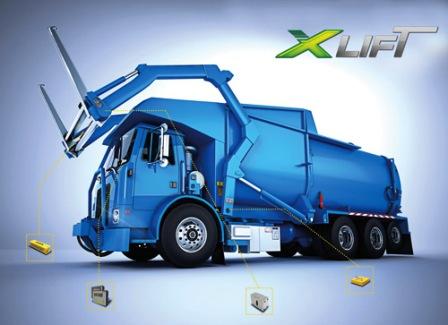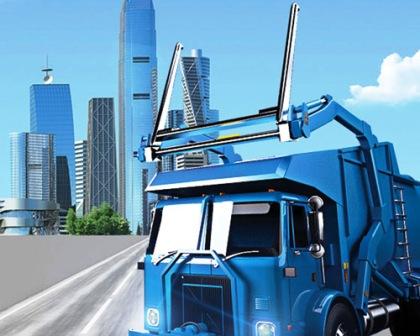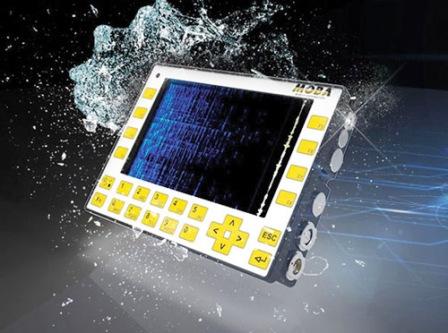On-board scales used to be the tactical side of successful waste and recycling hauling operations. Today they are strategic.
By Jerry McCurry
Surprising to many in the waste and recycling industry, the use of electronic on-board truck scales is not new. They were introduced more than three decades ago to vocational trucking applications where monitoring loaded vehicle weights were critical but platform scales were not readily accessible.
Some of the early adopters of on-board scale systems were logging operations where loggers loaded their trucks in remote areas. Overloading was a constant problem as fresh cut trees have different levels of moisture content and degrees of density thus making weight determinations of a full load nearly impossible. The threat of getting overweight tickets and fines was motivation for investing in this technology and escaping the seemingly unavoidable financial penalty of just trying to get a job done.
By the early 1990s, increased DOT truck weight enforcement in many states intensified and spilled over into other industries such as bulk, aggregate and waste hauling. Not knowing the weight of collected garbage began eating into haulers’ margins and reasons for using on-board scales suddenly made sense. Overloading issues were spreading and hauling companies were beginning to familiarize themselves with on-board scale options.
Over the Years: A Mixed Bag of Goods
While in the early days the goal was strictly overweight avoidance—this, of course, is still an important issue today—many operations also realized a need to know individual commercial container weights for determining profitability. Since haulers charged commercial customers by volume based on the size of their container, yet had to pay truck tipping fees at the landfill by weight (tonnage), how would they know which customers were profitable and which were not? It just didn’t add up.

This required more accurate ways to determine weight such as the use of load cells mounted between the truck body and chassis for both front loaders and rear loaders. At the same time, other less expensive transducer based systems were introduced to front loaders by such companies like Wray-Tech Inc. (WTI) and Mobile Computing Corporation (MCC). Differences between the competing scale manufacturers began to appear as each touted which was the better way to weigh garbage, load cells vs. transducers. It was also apparent that on-board computing was becoming part of the mix. Typically, software-based companies were warming up the market with robust software coupled with problematic weighing sensors, while scale based companies promoted accurate, durable and reliable weighing sensors with bare bones software capabilities.

It is interesting to note that many reputable companies such as Eaton, WTI, MCC, Hardy, Filing Scale, and others came into, and some quickly exited, the waste market during these years each promoting different combinations of on-board computing and/or on-board weighing. Some of these companies attempted to introduce certified legal-for-trade on-board scales, which caught on in Europe but not in North America.
What did finally stabilize was a handful of on-board scale providers each with different offerings to meet the growing need to know both total gross truck weights and individual pick-up weights. Most of these manufacturers are still in the waste market today.
Why “On-Board Scales Don’t Work”
Notice that the words above, on-board scales don’t work, are in quotation marks. That’s because on-board scales do work, but many say they don’t. Why is that? Understanding what makes up an on-board scale system is the first step to find the answer.
On-Board Scale System Configuration (Simplified)
- Hardware: The weighing sensor is usually either load cell- or transducer-based and both typically use strain gages at its core. The difference is that load cells are primary force measurement devices where the load path goes through the cell, thus they are very accurate. Secondary transducers are sensors that attach directly to existing structural parts of the truck (axles, walking beams, etc.) to measure small deflections in that part that is carrying the load.
- Electronics and Firmware: The electronic components include the readout and processor of the system and any wiring that attaches to the hardware. Within is an algorithm that processes the raw weights and filters out weight inaccuracies coming from the hardware. Getting accurate weights with the inherent pounding and vibrations of a garbage truck is where robust electronics with a well-written algorithm can make it (or break it) for an acceptable on-board scale system.
- Software: Software features vary a lot from one scale provider to the next. When weights are gathered, do we want to automatically obtain the gross weight, or attach an individual pickup weight to a customer’s name, address and location? Does the software allow for automatic processing of data, or is the driver having to get involved to make decisions based on manual weight readings? What is the user interface and how easy is it to retrieve the processed data?
Some scale suppliers have great hardware but lackluster algorithms to filter out the weight errors that occur in mobile weighing. Some software companies approach the market with powerful data gathering, processing and integration, but with a complete lack of consideration to robust and repeatable weighing hardware. The fact is, to make an on-board scale system great, there has to be a good balance of accurate hardware, solid electronics and a desired level of software.

Photos courtesy of MOBA Mobile Automation Group
Not only are the manufactures on the hook for making systems reliable, but on-board scales also “don’t work” because a lack of vision casting from the hauling company’s C-level management as to what the objectives are for the investment. The purchasing decision is frequently pushed down the management chain. Many times the cheapest systems are purchased without much forethought to the overall company strategy and to the dedication required to make the systems work properly day in and day out. Buying cheap is a sure bet to keep within budget, but could be a disaster when trying implement.
Often when an upper manager does ask about how the scale program is working, only after the on-board scale systems have been purchased, the response is “the scales don’t work.” That’s when the maintenance manager shrugs his shoulders and explains, “Hey, I’m just trying to keep trucks on the road and get the garbage off the street, scales are the least on my worries.” Okay, argument over.
Success in Matching the Right System to the Right Task
In all fairness to the maintenance and operations team at any hauling company, frustrations bubble up when someone on staff has to become the “on-board scale expert”, especially when no one mentioned upfront this would be the case. Scale calibration and maintenance can be time consuming. Often scales are either not working after a short time in the field or they lose accuracy due to a lack of ongoing calibration. This is true especially for simple transducer based systems that monitor gross vehicle loads. The lower cost comes with a higher level of setup and re-calibration. Mind you, this can be an excellent choice for many haulers as they can be good systems to avoid costly overweight issues, it’s just that everyone must be on the same page from the beginning and understand the upkeep requirements.
When it comes to front loaders, using on-board scales is effective to gather information on weights (profitability) per pickup per account. Expecting the driver to write down, print, or confirm on a tablet the correct customer weight data is not optimal. Drivers already have many responsibilities and making information gathering an additional responsibility leads to incomplete and inaccurate data matching. Fortunately, this type of system has seen many improvements over the last several years to where some load cell based systems are very accurate, the data collection functions are fully automatic and the driver just drives. GPS matching to assign weights to accounts with cloud based reporting gives a full picture of profitability per account.
Whichever system is chosen to accomplish the job, whether it’s a system for monitoring total weight or it’s one for gathering individual commercial pick-up weights, on-board scales do work well. They key to success is matching the right system with the right task. The old saying about don’t “bring a knife to a gunfight” rings true; no one wants an on-board scale system that is not an adequate match for the anticipated challenge.
What’s the Scope?
There’s no disputing that on-board scales provide many benefits to the haulers that use them. Some of the advantages include eliminating overweight fines and liability exposure, better load optimization, reduced fuel costs and increased revenues.
The difficulty is that there are many systems to choose from with different features and pricing structures. So a good way to get started with an on-board weighing program is to consider the five steps of the W.E.I.G.H. method:
- W – Write out all related weight issues or concerns, and take an inventory of problem areas.
- E – Evaluate all types of on-board scale technology to find the right solution for your application.
- I – Invest in a test or ‘pilot’ program with one or more of the technologies available.
- G – Gather test results, quantify cost/payback, and execute a program to meet operational goals.
- H – Harvest the positive results for years to come.
Today more than ever, it’s imperative that all projects have a scope management plan. The key is a strict focus for upper management to define the desired outcome for implementing such a program. The more time spent on developing a scope, the higher likelihood for successful implementation.
Conclusion … and What’s Next
Mobile technology is transforming the waste and recycling industry. The market trend for haulers is more competition and the continuous need to improve efficiency, increased enforcement of overweight regulations and a greater requisite for more information. On-board scale systems with seamless data collection and reporting are not only here to stay, but will continue to improve. Hauling companies who have properly matched the right on-board scale system to the right job are experiencing great results with a quick payback in investment.
What could come next for on-board weighing in North America? Scale manufacturers may offer more bundled equipment plans with pay-over-time options. The waste industry probably will see expansion of weight based pay-as-you-throw (PAYT) programs, which are already widespread in Europe, requiring certified legal for trade scales to resurface. The use of on-board system applications could expand to even more types of refuse trucks. For any of these possibilities one thing is certain: scale manufacturers will be ready to meet the demand.
Jerry McCurry is Business Unit Manager for the U.S. Waste Technology Division of MOBA Corp (Atlanta, GA), an established name in mobile automation specializing in the development and production of machine control systems, identification, mobile weighing technology and flexible software solutions. Jerry has dedicated more than 26 years to the recycling and solid waste industry. He has extensive experience with a wide range of mobile on-board scale applications. Jerry can be reached at (678) 817-9646, via e-mail at [email protected] or visit www.moba-automation.com.
